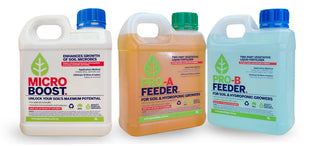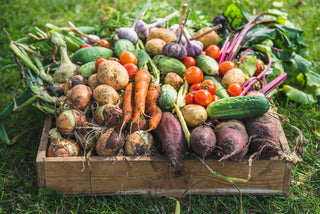Types of Aphids and How to Identify Them on Vegetables
Aphids are small, sap-sucking insects that can be found on a wide variety of plants, including vegetables in the garden. They come in different colors and species, each with unique characteristics. Here's an overview of the most common types of aphids, how to find them on your vegetables, and how they typically arrive in your garden.
1. Green Peach Aphid (Myzus persicae)
Description:
The Green Peach Aphid is one of the most common and widespread aphids. These aphids are typically light green, although they can vary in color from pink to yellow. They are small, about 1.5-2.5 mm long, with a pear-shaped body.
Vegetables Affected:
- Tomatoes
- Leafy greens
- Peppers
- Potatoes
- Eggplants
Where to Find Them:
Green Peach Aphids usually congregate on the underside of leaves, the tips of new growth, and around flower buds. Look for clusters of these small green insects, as well as signs of honeydew, a sticky substance they excrete.
How They Get There:
Green Peach Aphids can be spread by wind, by attaching to clothing, or by infested plants being brought into the garden. They reproduce rapidly, often giving birth to live young without the need for mating, leading to quick infestations.
2. Cabbage Aphid (Brevicoryne brassicae)
Description:
Cabbage Aphids are small, grayish-green, and covered with a waxy, powdery coating that gives them a bluish appearance. They tend to form dense colonies.
Vegetables Affected:
- Cabbage
- Broccoli
- Kale
- Cauliflower
Where to Find Them:
Cabbage Aphids are often found tightly packed together on the underside of leaves, particularly on the growing tips and in the folds of leaves. They can also be found on the stems of the plants.
How They Get There:
These aphids often arrive via transplants from nurseries or can be blown into the garden by the wind. They thrive in cool, moist conditions, which can lead to rapid population growth during the spring and fall.
3. Black Bean Aphid (Aphis fabae)
Description:
Black Bean Aphids are dark black or dark green and slightly larger than other aphid species, measuring about 2 mm in length. They have short legs and antennae, making them appear somewhat stocky.
Vegetables Affected:
- Beans
- Beets
- Spinach
- Potatoes
Where to Find Them:
These aphids prefer to feed on the growing tips of plants and the undersides of leaves. They often cluster around the stems and flowering parts of the plant.
How They Get There:
Black Bean Aphids can be introduced to the garden by flying in on the wind or by migrating from nearby plants. Ants often protect and farm them for the honeydew they produce, which can also aid their spread.
4. Potato Aphid (Macrosiphum euphorbiae)
Description:
Potato Aphids come in two color forms: green and pink. They are slightly larger than Green Peach Aphids, measuring around 2.5-3.5 mm in length. They have long, slender bodies with noticeable antennae and legs.
Vegetables Affected:
- Potatoes
- Tomatoes
- Peppers
- Lettuce
Where to Find Them:
Potato Aphids can be found on the undersides of leaves, on stems, and on the new growth of the plants. They often cause leaf curl and can lead to significant damage if not controlled.
How They Get There:
These aphids can migrate into the garden from surrounding weeds or be carried by the wind. They are also spread through infested plants and debris.
How to Identify Aphid Infestations
1. Look for Clusters:
Aphids are usually found in clusters on the undersides of leaves, around new growth, and on stems. Their presence can often be detected by the sticky honeydew they excrete, which can lead to the growth of sooty mold on the plant.
2. Check for Damage:
Signs of aphid damage include curled, yellowing, or deformed leaves, stunted growth, and a general decline in plant health. You may also notice ants on your plants, as they are attracted to the honeydew produced by aphids.
3. Inspect Regularly:
Regularly inspect your vegetable plants, especially during the growing season. Pay particular attention to the new growth and the undersides of leaves, as these are the areas where aphids tend to congregate.
How Aphids Get Into Your Garden
Aphids can enter your garden in several ways:
- Wind: Aphids can be carried by the wind over long distances, leading to sudden infestations.
- Infested Plants: Bringing in new plants from nurseries or other gardens can introduce aphids if the plants are infested.
- Ants: Ants often farm aphids for their honeydew and can transport them from one plant to another.
- Weeds: Aphids can migrate from nearby weeds, which serve as alternate hosts, into your vegetable garden.
By understanding the types of aphids that can affect your vegetables, where to find them, and how they typically arrive in your garden, you can take proactive steps to control these pests and protect your plants. Regular monitoring and prompt action are key to keeping your garden aphid-free.
| Method | Description | Effectiveness | Considerations |
|---|---|---|---|
| Biological Controls | Introducing natural predators like ladybugs, lacewings, or parasitic wasps. | High | Environmentally friendly, but may take time to establish populations. |
| Neem Oil | A natural pesticide derived from the neem tree. | Moderate to High | Safe for most plants, but can harm beneficial insects if overused. |
| Insecticidal Soap | A soap solution that kills aphids by disrupting their cell membranes. | High | Needs to be applied directly on aphids and repeated regularly. Safe for plants. |
| Horticultural Oils | Oils that suffocate aphids by coating their bodies. | High | Effective but should be used in the correct temperature range to avoid damaging plants. |
| Companion Planting | Planting species like garlic, chives, or marigolds that repel aphids. | Moderate | Works as a preventive measure, but may not eliminate established infestations. |
| Water Sprays | Using a strong jet of water to dislodge aphids from plants. | Moderate | Simple and chemical-free, but may need to be repeated often. |
| Sticky Traps | Yellow or blue sticky traps that attract and capture flying aphids. | Moderate | Useful for monitoring and reducing aphid populations, but not a complete solution. |
| Organic Pesticides | Pesticides based on natural ingredients, such as pyrethrins or spinosad. | High | Effective but can harm beneficial insects. Should be used as a last resort. |
| Cultural Practices | Regularly removing weeds and inspecting plants for early signs of aphids. | Preventive | Helps reduce aphid populations but requires consistent effort. |
| Chemical Pesticides | Synthetic pesticides targeting aphids. | Very High | Effective, but can harm non-target species, including beneficial insects. Should be used with caution and according to label instructions. |
This chart provides an overview of the most common methods to control aphids, along with their effectiveness and considerations.





